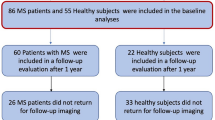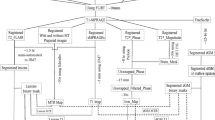Abstract
Background and purpose
Corpus callosum (CC) is frequently involved in relapsing–remitting multiple sclerosis (RRMS). Magnetic resonance imaging (MRI) and diffusion tensor imaging (DTI) allow to study CC macrostructural and microstructural tissue integrity. Here, we applied a data-driven approach to MRI and DTI data of normal-appearing CC in RRMS subjects, and subsequently evaluated if differences in tissue integrity corresponded to different levels of physical disability and cognitive impairment.
Methods
74 RRMS patients and 20 healthy controls (HC) underwent 3 T MRI and DTI. Thickness and fractional anisotropy (FA) along midsagittal CC were extracted, and values from RRMS patients were fed to a hierarchical clustering algorithm. We then used ANOVA to test for differences in clinical and cognitive variables across the imaging-based clusters and HC.
Results
We found three distinct MRI-based subgroups of RRMS patients with increasing severity of CC damage. The first subgroup showed callosal integrity similar to HC (Cluster 1); Cluster 2 had milder callosal damage; a third subgroup showed the most severe callosal damage (Cluster 3). Cluster 3 included patients with longer disease duration and worst scores in Expanded Disability Status Scale. Cognitive domains of verbal memory, executive functions and processing speed were impaired in Cluster 3 and Cluster 2 compared to Cluster 1 and HC.
Conclusions
Within the same homogeneous cohort of patients, we could identify three neuroimaging RRMS clusters characterized by different involvement of normal-appearing CC. Interestingly, these corresponded to three distinct levels of clinical and cognitive disability.


Similar content being viewed by others
References
Gean-Marton AD, Vezina LG, Marton KI et al (1991) Abnormal corpus callosum: a sensitive and specific indicator of multiple sclerosis. Radiology 180:215–221
Rogers JM, Panegyres PK (2007) Cognitive impairment in multiple sclerosis: evidence-based analysis and recommendations. J Clin Neurosci 14:919–927
Chiaravalloti ND, DeLuca J (2008) Cognitive impairment in multiple sclerosis. Lancet Neurol 7:1139–1151
Pelletier J, Suchet L, Witjas T et al (2001) A longitudinal study of callosal atrophy and interhemispheric dysfunction in relapsing–remitting multiple sclerosis. Arch Neurol 58:105–111
Granberg T, Martola J, Bergendal G et al (2015) Corpus callosum atrophy is strongly associated with cognitive impairment in multiple sclerosis: results of a 17-year longitudinal study. Mult Scler 21:1151–1158
Gonçalves LI, Dos Passos GR, Conzatti LP et al (2018) Correlation between the corpus callosum index and brain atrophy, lesion load, and cognitive dysfunction in multiple sclerosis. Mult Scler Relat Disord 20:154–158
Yaldizli O, Penner IK, Frontzek K et al (2014) The relationship between total and regional corpus callosum atrophy, cognitive impairment and fatigue in multiple sclerosis patients. Mult Scler 20:356–364
Hasan KM, Gupta RK, Santos RM et al (2005) Diffusion tensor fractional anisotropy of the normal-appearing seven segments of the corpus callosum in healthy adults and relapsing remitting multiple sclerosis patients. J Magn Reson Imaging 21:735–743
Sigal T, Shmuel M, Mark D et al (2012) Diffusion tensor imaging of corpus callosum integrity in multiple sclerosis: correlation with disease variables. J Neuroimaging 22:33–37
Van Schependom J, Gielen J, Laton J et al (2017) The effect of morphological and microstructural integrity of the corpus callosum on cognition, fatigue and depression in mildly disabled MS patients. Magn Reson Imaging 40:109–114
Zhang X, Zhang F, Huang D et al (2016) Contribution of grey and white matter abnormalities to cognitive impairment in multiple sclerosis. Int J Mol Sci 18:46
Rimkus Cde M, Junqueira Tde F, Callegaro D et al (2013) Segmented corpus callosum diffusivity correlates with Expanded Disability Status Scale score in the early stages of relapsing–remitting multiple sclerosis. Clinics (Sao Paulo) 68:1115–1120
Ozturk A, Smith SA, Gordon-Lipkin EM et al (2010) MRI of the corpus callosum in multiple sclerosis: association with disability. Mult Scler 16:166–177
Polman CH, Reingold SC, Banwell B et al (2011) Diagnostic criteria for multiple sclerosis: 2010 revisions to the McDonald Criteria. Ann Neurol 69:292–302
Amato MP, Portaccio E, Goretti B et al (2006) The Rao’s Brief Repeatable Battery and Stroop Test: normative values with age, education and gender corrections in an Italian population. Mult Scler 12:787–793
Adamson CL, Wood AG, Chen J et al (2011) Thickness profile generation for the corpus callosum using Laplace’s equation. Hum Brain Mapp 32:2131–2140
Johnson RA, Wichern DW (1982) Applied multivariate statistical analysis. Prentice Hall, Upper Saddle River
Caligiuri ME, Barone S, Cherubini A et al (2014) The relationship between regional microstructural abnormalities of the corpus callosum and physical and cognitive disability in relapsing–remitting multiple sclerosis. Neuroimage Clin 7:28–33
Cerasa A, Valentino P, Chiriaco C et al (2013) MR imaging and cognitive correlates of relapsing–remitting multiple sclerosis patients with cerebellar symptoms. J Neurol 260:1358–1366
Rimkus Cde M, Junqueira Tde F, Lyra KP et al (2011) Corpus callosum microstructural changes correlate with cognitive dysfunction in early stages of relapsing–remitting multiple sclerosis: axial and radial diffusivities approach. Mult Scler Int 2011:304875
Denney DR, Lynch SG (2009) The impact of multiple sclerosis on patients’ performance on the Stroop test: processing speed versus interference. J Int Neuropsychol Soc 15:451–458
Fischer M, Ryan SB, Dobyns WB (1992) Mechanisms of interhemispheric transfer and patterns of cognitive function in acallosal patients of normal intelligence. Arch Neurol 49:271–277
Bettcher BM, Mungas D, Patel N et al (2016) Neuroanatomical substrates of executive functions: beyond prefrontal structures. Neuropsychologia 85:100–109
Brown WS, Thrasher ED, Paul LK (2001) Interhemispheric Stroop effects in partial and complete agenesis of the corpus callosum. J Int Neuropsychol Soc 7:302–311
Author information
Authors and Affiliations
Corresponding author
Ethics declarations
Ethical standards
All study procedures involving human subjects were approved by the local Institutional Review Board, and have been performed in accordance with the ethical standards laid down in the 1964 Declaration of Helsinki and its later amendments.
Informed consent
All the study participants gave written informed consent prior to their inclusion in the study.
Conflicts of interest
On behalf of all authors, the corresponding author states that there is no conflict of interest.
Rights and permissions
About this article
Cite this article
Barone, S., Caligiuri, M.E., Valentino, P. et al. Multimodal assessment of normal-appearing corpus callosum is a useful marker of disability in relapsing–remitting multiple sclerosis: an MRI cluster analysis study. J Neurol 265, 2243–2250 (2018). https://doi.org/10.1007/s00415-018-8980-y
Received:
Accepted:
Published:
Issue Date:
DOI: https://doi.org/10.1007/s00415-018-8980-y




